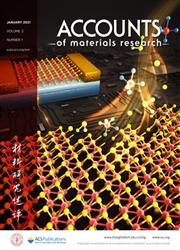Perspectives of Flexible Thermoelectric Fibers by Thermal Drawing Techniques
IF 14
Q1 CHEMISTRY, MULTIDISCIPLINARY
引用次数: 0
Abstract
Wearable devices are increasingly being used to prevent diseases and to enhance physical health. However, this advancement comes with the challenge of high power consumption. Existing portable power storage or generation solutions often fail to meet the requirements for uninterrupted power supply, compact size, light weight, and low noise. Thermoelectric materials have emerged as a promising solution for portable energy supplies due to their ability to directly convert body heat into electricity. These materials not only provide clean energy for wearable devices but also support solid-state refrigeration, temperature sensing, and monitoring functions. Nevertheless, conventional inorganic materials with high thermoelectric properties face several challenges, such as brittleness, poor postprocessing capabilities, large size, complex preparation procedures, and high cost, limiting their suitability for heat sources with irregular surfaces. Conversely, while organic thermoelectric materials are more flexible, they exhibit weak thermoelectric performance and cannot meet the growing power demands of modern wearable devices. Recently, through thermal drawing technology, high-performance inorganic materials can be fabricated into flexible thermoelectric fibers, combining excellent thermoelectric properties with flexibility. These fibers are capable of harvesting waste heat to generate electricity, assisting in body temperature regulation, and measuring the temperature of irregular heat sources, thereby meeting the requirements of wearable devices. Wearable fabric devices woven from inorganic thermoelectric fibers retain the thermoelectric efficiency of bulk inorganic materials while offering additional benefits such as washability, fatigue resistance, portability, and the potential for large-scale and low-cost production. These advantages enable wearable thermoelectric devices to operate effectively in diverse and challenging environments. However, current commercial equipment is difficult to accurately measure micrometer/nanometer-scale fiber thermoelectric fibers. Herein, we have developed an in situ measurement system for the thermoelectric properties of micro/nanoscale materials, which can perform integrated in situ testing of the electrical conductivity, Seebeck coefficient, and thermal conductivity of thermoelectric fibers, reducing the measurement uncertainty compared to measuring multiple parameters for multiple samples separately.

用热拉伸技术研究柔性热电纤维的前景
可穿戴设备越来越多地用于预防疾病和增强身体健康。然而,这种进步伴随着高功耗的挑战。现有的便携式电力存储或发电解决方案往往不能满足不间断供电、体积小、重量轻和低噪音的要求。热电材料已经成为便携式能源供应的一个有前途的解决方案,因为它们能够直接将人体热量转化为电能。这些材料不仅为可穿戴设备提供清洁能源,还支持固态制冷、温度传感和监控功能。然而,具有高热电性能的传统无机材料面临着脆性、后处理能力差、尺寸大、制备工艺复杂、成本高等挑战,限制了其对不规则表面热源的适用性。相反,有机热电材料虽然更灵活,但热电性能较弱,无法满足现代可穿戴设备日益增长的功率需求。最近,通过热拉伸技术,高性能无机材料可以制成柔性热电纤维,将优异的热电性能与柔性相结合。这些纤维可以收集余热发电,帮助调节体温,测量不规则热源的温度,从而满足可穿戴设备的要求。由无机热电纤维编织的可穿戴织物设备保留了大块无机材料的热电效率,同时提供了额外的优点,如可洗涤性、抗疲劳性、便携性以及大规模和低成本生产的潜力。这些优点使可穿戴热电设备能够在各种具有挑战性的环境中有效运行。然而,目前的商用设备难以精确测量微米/纳米尺度的热电纤维。在此,我们开发了一种微/纳米材料热电性能的原位测量系统,该系统可以对热电纤维的电导率、塞贝克系数和导热系数进行集成的原位测试,与单独测量多个样品的多个参数相比,减少了测量的不确定度。
本文章由计算机程序翻译,如有差异,请以英文原文为准。
求助全文
约1分钟内获得全文
求助全文

 求助内容:
求助内容: 应助结果提醒方式:
应助结果提醒方式:


